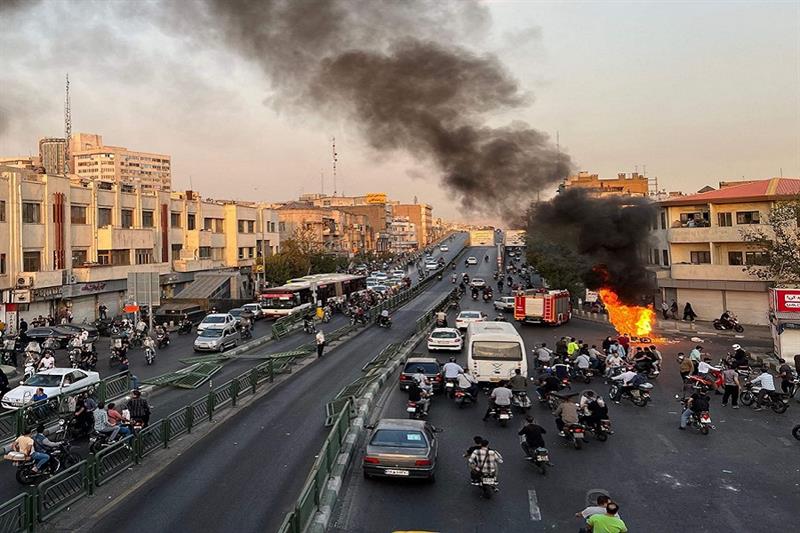
A motorcycle was on fire during protests in Tehran on October 8, 2022. AFP
The incidents come as demonstrations rage on in cities, towns and villages across Iran over the Sept. 16 death of Mahsa Amini, who died days after being detained by the morality police in Tehran.
While Iran's government insists Amini was not mistreated, videos of violent confrontations between women wearing their mandatory headscarf, or hijab, loosely have sparked suspicion she suffered physical abuse during her detention.
From Tehran and elsewhere, online videos have emerged despite authorities disrupting the internet showing women marching through the streets without the hijab, while others confront authorities and light fires in the street as the protests continue into the fourth week.
The demonstrations represent one of the biggest challenges to Iran's theocracy since the 2009 Green Movement protests.
The violence early Monday occurred in Sanandaj, the capital of Iran's Kurdistan province, as well as in the village of Salas Babajani near the border with Iraq, according to a Kurdish group called the Hengaw Organization for Human Rights.
Amini was a Kurdish woman and her death has been particularly felt in Iran's Kurdish region, where demonstrations began Sept. 17 at her funeral there.
Hengaw posted footage it described as smoke rising in one neighbourhood in Sanandaj, with what sounded like rapid rifle fire echoing through the night sky as the shouts of people could be heard.
There was no immediate word if people had been hurt in the violence. Hengaw later posted a video online of what appeared to be collected shell casings from rifles and shotguns, as well as spent tear gas canisters.
Authorities offered no immediate explanation about the violence early Monday in Sanandaj, some 400 kilometers (250 miles) west of Tehran. Esmail Zarei Kousha, the governor of Iran's Kurdistan province, alleged without providing evidence that unknown groups ``plotted to kill young people on the streets'' on Saturday, the semiofficial Fars news agency reported Monday.
Kousha also accused these unnamed groups that day of shooting a young man in the head and killing him _ an attack that activists roundly have blamed on Iranian security forces.
They say Iranian forces opened fire after the man honked his car horn at them. Honking has become one of the ways activists have been expressing civil disobedience _ an action that has seen riot police in other videos smashing the windshields of passing vehicles.
In the village of Salas Babajani, some 100 kilometers (60 miles) southwest of Sanandaj, Iranian security forces repeatedly shot a 22-year-old man protesting there who later died of his wounds, Hengaw said. It said others had been wounded in the shooting.
It remains unclear how many people have been killed in the demonstrations and the security force crackdown targeting them. State television last suggested at least 41 people had been killed in the demonstrations as of Sept. 24. In the over two weeks since there's been no update from Iran's government.
An Oslo-based group called Iran Human Rights estimates at least 185 people have been killed, though that includes an estimated 90 people killed in violence in the eastern Iranian city of Zahedan.
Iranian authorities have described the Zahedan violence as involving unnamed separatists, though Iran Human Rights said the incident began as a protest over a separate incident involving rape allegations against a local police officer.
Meanwhile, a prison riot has struck the city of Rasht, killing some inmates there, a prosecutor reportedly said. It wasn't immediately clear if the riot at Lakan Prison involved the ongoing protests, though Rasht has seen heavy demonstrations in recent weeks since Amini's death.
The semiofficial Mehr news agency quoted Gilan provincial prosecutor Mehdi Fallah Miri as saying ``some prisoners died because of their wounds as the electricity was cut (at the prison) because of the damage.'' He also alleged prisoners refused to allow authorities to access those wounded.
Miri described the riot as breaking out in a wing of a prison housing death penalty inmates.
Short link: